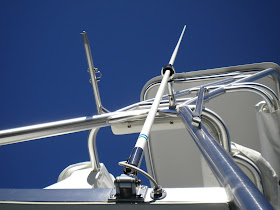The phone rings, and I answer the call. It's Bob, "Hi Bob, what's up. You're in the Bahamas with your family? Sounds nice. Your grandson accidentally changed the Garmin chart plotter's language to one you can't read? Calm down Bob, we can fix up the little urchin's faux pas in short order. You have your waypoints backed up like I suggested don't you? You forgot? Okay we can still fix things up, no worries. Okay Bob, no matter what it now says, touch the small button in the very upper left corner of the screen. Did a bunch of big blue buttons appear? Good deal Bob, now look at the big blue buttons. See the one with the gears on it? Touch it, and don't touch anything else. Let me think about this for a second. Touch the second button down on the blue button list at right, that should be Preferences, I think. Now touch the second blue button down again on the new list. Good, do you see English, or Americanized English on any of the buttons, either will do. Yes? Excellent touch it. Can you read it now? You're welcome Bob, keep the kids, away from the nav gear, and don't forget to back up your waypoints. The little tyke could have done a factory reset, and then you would really be in a jam."
I do this sort of support often, and I am pretty good at it, to a point. If I have to go any deeper into the menu trees, the dialog starts to have a lot of, "Okay Bob, read me the list you see. Good, now touch "device list".
I was really excited when I saw the Garmin chart plotter simulator you see below. Boy would this make my life easier. I could actually see what the client sees, when I have to do this sort of remote diagnostics. I was ready to download it on my "murse" (it's Kate's word for a man purse, my net book with all of my nav update software, pdf manuals, and cables), But I have to pull up on the reins. It works perfectly, with a terrific format, but only for a couple of layers down, and then it just stops. I think this could be a great tool, both from a support viewpoint, but also an excellent training aid. And it would be good, at least for me, if everybody developed a version of this, for their larger and more complex systems, and I'm now also musing out loud to Raymarine, Navico, Furuno, and all of the others in this line of endeavor. This is a grand idea.
I do this sort of support often, and I am pretty good at it, to a point. If I have to go any deeper into the menu trees, the dialog starts to have a lot of, "Okay Bob, read me the list you see. Good, now touch "device list".
I was really excited when I saw the Garmin chart plotter simulator you see below. Boy would this make my life easier. I could actually see what the client sees, when I have to do this sort of remote diagnostics. I was ready to download it on my "murse" (it's Kate's word for a man purse, my net book with all of my nav update software, pdf manuals, and cables), But I have to pull up on the reins. It works perfectly, with a terrific format, but only for a couple of layers down, and then it just stops. I think this could be a great tool, both from a support viewpoint, but also an excellent training aid. And it would be good, at least for me, if everybody developed a version of this, for their larger and more complex systems, and I'm now also musing out loud to Raymarine, Navico, Furuno, and all of the others in this line of endeavor. This is a grand idea.
Now on to chart plotter cable plugs, and boat builders. As the navigation systems have become faster, and do more things, they have gotten larger, and deeper. This coupled with the plugs, which sometimes to me, looks like my modestly exaggerated example of a chart plotter's power plug shown below can make installations difficult.
So first the boat builders. I am still amazed at the lack of forethought I see in many helm layouts. Sure they look pretty, but why didn't you think, after the customer spent $100,000 on the boat, he would only want to install a chartplotter with a 4" screen, because that's all you left room for. Sometimes they look big, but behind them, all too often there is not a lot of depth, which can require all sorts of gyrations to get systems to fit, if at all. While I am on this subject, I want to remind all boat builders, that modern navigation systems require wires, and sometimes lots of them, coming from various places on the boat, so ponder on that when you do your next design. "I want to say one word to you. Just one word. Conduits." (sorry Mrs Robinson). And as long I'm ranting, this business of building a "Fishing" boat that has an anchor locker design you can't install a winch on has got to stop. Are the people that make that orange ball paying you to do this?
For the chart plotter manufacturers, I know there is a ton of wiring that that has to go to your systems, and that things need to be water resistant, but as your systems get deeper, look for ways to keep the plugs from exacerbating the problems, and dimensional drawings of the equipment should also reflect the depth needed with the plugs.
My final wish is that everybody has a safe and prosperous new year, and steer small damn your eyes.












































